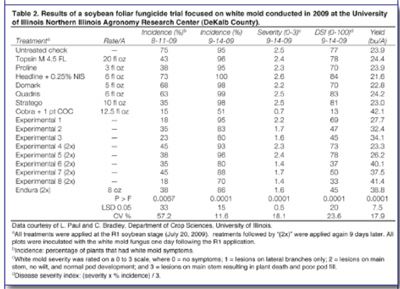Soybean White Mold Fungicide Trial Results
URBANA, ILL.
A soybean foliar fungicide trial focused on white mold (Sclerotinia stem rot, caused by Sclerotinia sclerotiorum) was conducted at the University of Illinois Northern Illinois Agronomy Research Center in DeKalb County this year. Results are presented in Table 2.

The treatments included products currently registered for white mold control in soybean (Topsin, Domark, and Endura) and those registered for control of other soybean diseases (Proline, Headline, Quadris, and Stratego). Some experimental treatments not registered on soybean were included. In addition, Cobra herbicide, which has white mold suppression listed on its label was included. In our trial, Cobra herbicide was applied at 12.5 fl oz/A; however, Valent’s recommendation is 6 to 8 fl oz/A for white mold suppression in soybean. All treatments were applied at the R1 soybean growth stage (July 20), and a few experimental treatments were applied again nine days later.
The trial was conducted in a manner that would promote high disease pressure. Seed was planted in narrow (7-1/2-inch) rows at a high seeding rate. In addition, sterilized oat grains infected with the white mold fungus were spread throughout the entire experimental area one day after fungicides were applied at the R1 stage.
Keep in mind that one can’t jump to conclusions when a field trial is conducted at only one location in only one year. The results observed in this trial will thus not be the same ones observed every time these treatments are applied. White mold disease pressure was very high in this trial. The incidence ratings collected approximately 3 weeks after the R1 treatment applications give an indication of product efficacy, but most of the treatments applied only once did not provide a long enough window of protection as observed by the incidence and severity ratings collected later in the season.
Overall in this trial, Cobra herbicide did a good job of suppressing white mold, which resulted in a yield benefit. For more information on Cobra and Topsin M for control of white mold, see a report from the University of Wisconsin (Adobe PDF), where these treatments were evaluated for white mold control in their trials in the 1990s. Δ
CARL A. BRADLEY: Extension Plant Pathologist, University of Illinois